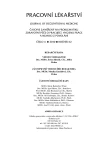Contamination of the chemotherapeutic outpatient clinic in the Masaryk Memorial Cancer Institute – evaluation of efficiency of implemented corrective measure
Authors:
L. Doležalová 1; P. Odráška 1,2,3; L. Gorná 1; J. Kuta 3; M. Oravec 3; M. Prudilová 1; R. Vejpustková 1; L. Bláha 2,3
Authors‘ workplace:
Ústavní lékárna, Masarykův onkologický ústav, Brno, vedoucí organizace prof. MUDr. Jiří Vorlíček, CSc.
1; Oddělení laboratorní medicíny, Masarykův onkologický ústav, Brno, primář doc. MUDr. Dalibor Valík, Ph. D.
2; Centrum pro výzkum toxických látek v prostředí – RECETOX, Přírodovědecká fakulta, Masarykova univerzita, Brno, ředitel prof. RNDr. Ivan Holoubek, CSc.
3
Published in:
Pracov. Lék., 62, 2010, No. 4, s. 158-163.
Category:
Original Papers
Overview
Handling with cytotoxic drugs (CDs) often lead to contamination of the working environment and to occupational exposure of the present staff. Our previous monitoring study, which focused on contamination of various workplaces at the Masaryk Memorial Cancer Institute, identified relatively high and frequent contamination in the outpatient clinic. With the aim to reduce the contamination of the outpatient clinic three innovative protective measures were suggested. The main objective of this study was to compare the contamination of the outpatient clinic before and after the implementation of the set of measures.
The set of measures included (i) replacement of the standard infusion sets by multichannel sets enabling the final rinsing of the set by neutral solution, which prevent an inadvertent spillage after the disconnection of the set from the patient venous entry; (ii) replacement of the IV stands by implementation of the wall-mounted IV stands enabling appropriate and regular cleaning of the floor, (iii) elimination of standing urination supported by the toilets with self cleaning toilet seats. Monitoring of the contamination was performed by the determination of cyclophosphamide in the wipe samples collected from hands of the workers and surfaces of selected objects (working table, phone receiver, floor below IV stand and at WC, display of the infusion pump).
The level of surface contamination by cyclophosphamide decreased approximately by one order of magnitude at all objects monitored. The decrease in contamination was statistically significant at all objects except the infusion pump, where significance was not reached due to high variability. Cyclophosphamide concentration at the most contaminated object (floor under the IV stand) decreased from 6700 ± 5300 pg/cm2 to 550 ± 200 pg/cm2. The highest reduction in contamination was observed at the telephone, where concentration decreased from 390 ± 240 to 10 ± 5 pg/cm2. The range of concentrations found on the workersę hands decreased from 11–361 to 5–21 ng/both hands and the frequency of positive results decreased from 7/13 to 4/13.
Implemented protective measures were found effective. Their implementation lead to the reduction of surface contamination and hand exposure of the nurses administering CDs to the patients. Therefore, the authors highly recommend implementation/adoption of the measures also in other outpatient clinics.
Key words:
antineoplastic agents, occupational exposure, surface contamination, administration of cytotoxic drugs
Sources
1. BAKER, G. L., KAHL, L. E., ZEE, B. C., STOLZER, B. L., AGARWAL, A. K., MEDSGER, T. A. Malignancy Following Treatment of Rheumatoid-Arthritis with Cyclophosphamide – Long-Term Case-Control Follow-up-Study. Am. J. Med., 1987, 83, 1, s. 1–9.
2. CONNOR, T. H., ANDERSON, R. W. et al. Surface contamination with antineoplastic agents in six cancer treatment centers in Canada and the United States. Am. J. Health - -System Pharmacy, 1999, 56 (14), s. 1427–1432.
3. DOLEŽALOVÁ, L., ODRÁŠKA, P., GORNÁ, L., KUTA, J., ORAVEC, M., PRUDILOVÁ, M., VEJPUSTKOVÁ, R., BLÁHA, L. Studium kontaminace pracovišť a profesionální expozice zdravotnických pracovníků zajišťujících přípravu a aplikaci protinádorových léčiv. Pracov. Lék., 61, 2009, No. 3, s. 117–122.
4. FRANSMAN, W., VERMEULEN, R. et al. Dermal exposure to cyclophosphamide in hospitals during preparation, nursing and cleaning activities. Inter. Arch. Occup. Environ. Health, 2005, 78 (5), s. 403–412.
5. FUCHS, J., HENGSTLER, J.G., JUNG, D., HILTL, G., KONIETZKO, J., OESCH, F. DNA damage in nurses handling antineoplastic agents. Mutation Research/Genetic Toxicology, 1995, 342, 1–2, s. 17–23.
6. HEDMER, M., TINNERBERG, H. et al. Environmental and biological monitoring of antineoplastic drugs in four workplaces in a Swedish hospital. Inter. Arch. Occup. Environ. Health, 2008, 81 (7), s. 899–911.
7. HEMMINKI, K., KYYRONEN, P., LINDBOHM, M. L. Spontaneous-Abortions and Malformations in the Offspring of Nurses Exposed to Anesthetic-Gases, Cytostatic Drugs, and Other Potential Hazards in Hospitals, Based on Registered Information of Outcome. J. Epidemiol. Community Health, 1985, 39, 2, s. 141–147.
8. KROMHOUT, H., HOEK, F. et al. Postulating a dermal pathway for exposure to anti-neoplastic drugs among hospital workers 2000. Ann. Occup. Hyg., 44 (7), s. 551–560.
9. KRSTEV, S., PERUNICIC, B., VIDAKOVIC, A. Work practice and some adverse health effects in nurses handling antineoplastic drugs. Med. Lav., 2003, 94, 5, s. 432–439.
10. MAYDL, A., SCHIERL, R. ET AL. Kontaminationen mit Zytostatika auf Stationen in Krankenhäusern. Krankenhauspharmazie, 2005, 26, s. 391–397.
11. ODRASKA, P., DOLEZALOVA, L., GORNA, L., PRUDILOVA, M., BLAHA, L. Occupational exposure of healthcare professionals to antineoplastic agents in Masaryk Memorial Cancer Institute. Brno, Abstract. Interdisciplinary Toxicology, 2009, 2 (2), s. 132.
12. ODRÁŠKA, P., GORNÁ, L., DOLEŽALOVÁ, L., ORAVEC, M., KUTA, J., BLÁHA, L. Monitoring povrchové kontaminace cytotoxickými léčivy v nemocničních lékárnách České republiky. Čes. slov. Farm., 2009, 58, s. 225–229.
Labels
Hygiene and epidemiology Hyperbaric medicine Occupational medicineArticle was published in
Occupational Medicine

2010 Issue 4
Most read in this issue
- Occupational diseases in the Slovak Republic from the perspective of clinical occupational medicine
- The role of the community nurse in providing occupational preventive care
- Analysis of mortality on malignant and non-malignant diseases of respiratory tract in miners with coal-workers pneumoconiosis in the Czech Republic
- Contamination of the chemotherapeutic outpatient clinic in the Masaryk Memorial Cancer Institute – evaluation of efficiency of implemented corrective measure
